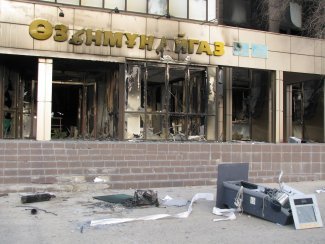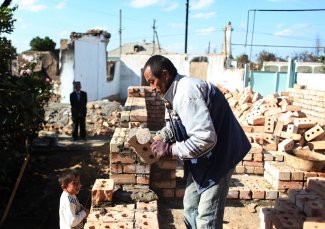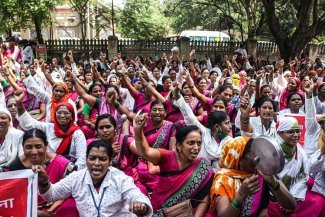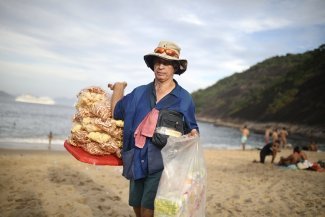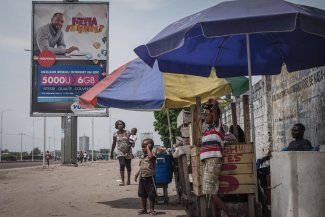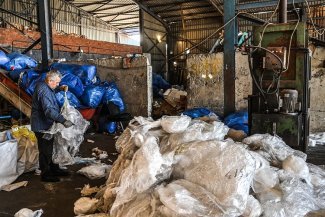Police officers stand guard near the Presidential Palace, on 6 January 2022, as Kazakhstan declared a state of emergency after protests against the increase in fuel prices spread across the country.
Since the beginning of January 2022, Kazakhstan has found itself in the throes of a social and political crisis of unprecedented proportions. Popular demonstrations, armed riots and an attempted coup d’état have shaken Central Asia’s largest and richest country.
After President Kasym-Jomart Tokayev was forced to have temporary recourse to the Collective Security Treaty Organisation (editor’s note: CSTO, a Russian-led, mutual defence alliance comprising six post-Soviet states in Eurasia) to restore order, much geopolitical analysis followed. This should not obscure the structural causes of the events that have shaken a country long presented as a model of stability.
From 2 January 2022, there were demonstrations in every region of Kazakhstan to protest against the increase in the price of liquefied natural gas following the lifting of the set price fixed by the government.
This lifting of price controls on fuel, which removed one of the mechanisms for redistributing the revenue from raw materials, provoked discontent, especially as the country was already experiencing high inflation in the wake of the Covid-19 pandemic (+7.5 per cent in 2020, +8.4 per cent in 2021). In particular, the daily life of the Kazakh people was already affected by rising food prices.
Popular discontent is also rooted in the extent of inequality in Kazakh society and territory, which is largely the result of the liberal and authoritarian policies pursued since independence.
Alongside the political and economic elite built around the first president, Nursultan Nazarbayev, who came to power at the end of the Soviet period, and the middle class that has emerged in the big cities, large sections of society have remained on the margins of growth.
Despite a spectacular economic boom during the 2000s and 2010s, largely based on the exploitation of underground resources (oil, gas, coal, uranium, etc.), poverty remains high. It affects the countryside as well as the cities, especially the industrial cities integrated into the Soviet production system (such as Karaganda, the fourth most populous city in the country), which were the most affected by the crisis of the 1990s, which saw Kazakh GDP contract by almost 40 per cent between 1991 and 1995. In concrete terms, this situation translates into living and working conditions that are still very harsh for many Kazakhs.
The clientelist presidential rule that characterises the Kazakh political system also fuelled tensions. Democratisation was one of the demands made during the demonstrations (return to the 1993 Constitution guaranteeing the rights of political and trade union organisations; election of mayors and regional presidents; denunciation of Nazarbayev’s personality cult; consolidation of freedom of information), particularly by civil society activists, while the phenomena of corruption and the appropriation of wealth by those in power and their entourage were denounced.
Hence it is the whole oligarchic system forged by Nazarbayev that has been called into question in the popular demonstrations, regardless of the geopolitical analyses of the crisis. The social contract, which was also based on patriotic identification with the economic and political successes of the state, has largely broken down as a result of the slowdown in growth (-2.5 per cent in 2020).
Peaceful demonstrations and armed riots
The protests took different forms in different cities and regions, while for the first time discontent spread across the country, beginning in the city of Zhanaozen in western Kazakhstan.
Located in one of the main hydrocarbon producing regions, the city occupies a unique place in the political and social history of the country. It is one of the centres of a region – Mangystau – whose population is known to have always shown a certain mistrust towards the central authorities, Tsarist, Soviet and now Kazakh, as shown by the low vote obtained by Tokayev in 2019 in the last presidential election. Before that, in 2011, Zhanaozen was the scene of major strikes in the hydrocarbon sector, the repression of which, on the anniversary of 20 years of independence, officially left 17 dead.
In the western and northern regions, popular discontent was generally expressed in peaceful demonstrations marked by a large trade union presence. However, in the cities of the east and especially the south, from Kyzyl-Orda to Taldy-Kurgan, via Chymkent, Taraz and especially Almaty, the country’s largest city with around two million inhabitants, the demonstrations turned into riots.
On the one hand, young men, often from impoverished backgrounds, recently arrived in the city (or still living in the surrounding villages), essentially Kazakh-speaking, and who had initially demonstrated peacefully, violently expressed their anger by looting and attacking symbols of the regime, such as the offices of the Nur Otan party (meaning the ‘radiant fatherland’) created by Nazarbayev.
On the other hand, more organised groups, presumably linked to criminal organisations, Islamist networks and political figures, attacked public buildings, but also the airport and the television tower in Almaty, while important members of the security organs, notably within the KNB (the National Security Committee, Kazakhstan’s intelligence agency), defected.
The takeover was described by Tokayev as an “anti-terrorist operation” – a phrase that allowed him to justify the imposition of a state of emergency, the unrestrained crackdown on “bandits” and the call for peacekeeping forces from CSTO member countries. It was also presented as the defeat of an attempted coup.
In total, according to the authorities, the violence claimed 227 victims, including more than 200 civilians, mostly in Almaty, as well as several thousand injured. Around 10,000 people have been arrested, while the repression has largely targeted civilians and activists not involved in the violence, despite announcements by the head of state.
A political crisis on several levels
This political crisis, which has left Kazakh society in a state of shock, must be seen on several levels.
On the one hand, the ‘January tragedy’ is a reminder that Kazakhstan has experienced several episodes of socio-political tension in recent years: protests against land reforms in 2016, the denunciation of housing and poverty problems after a tragic fire in Astana (the capital of Kazakhstan, now called Nur-Sultan) in which five children from the same family died in 2019, and inter-ethnic clashes in 2020 near the Kyrgyz border.
On the other hand, it reveals the extent of the gap between the state apparatus and a large part of the population, both politically and socially. This gap is linked, among other things, to the fact that the Kazakh political system is based less on elections than on appointments, and that it lacks, in practice, bodies for representation, confrontation, and deliberation.
Finally, the January events constitute a new stage in addressing the succession to Nazarbayev. In parallel to the popular movement, an attempt to overthrow Kasym-Jomart Tokayev seems to have been initiated by people close to the former president.
The president of the KNB, Karim Massimov, himself a former prime minister, is said to have asked President Tokayev to resign after the first demonstrations, before being himself removed and then arrested and accused of “high treason”. In other words, internal power struggles have been grafted onto social discontent. And it would be reasonable to think they are largely responsible for the explosion of violence.
After having established himself in the institutional architecture, notably by taking over the presidency of the Security Council, one of the major challenges for Preisdent Tokayev today is to build a popular base, whereas the manner of his accession to the presidency has until now limited his legitimacy to the point where certain political scientists described the Kazakh political system as a “dyarchy” and considered Tokayev to be a “half-president”.
A “new Kazakhstan” without Nazarbayev?
The sequence that began in early January 2022 constitutes a turning point in the contemporary history of Kazakhstan. It marks the end of the political life of Nursultan Nazarbayev, who described himself as “retired” on 18 January in a short speech reaffirming his support for President Tokayev.
On 11 January, in a long speech to parliament, Tokayev invoked the construction of a “new Kazakhstan” to describe his action, in the same way that the rhetoric developed by Shavkat Mirziyoyev promotes the “new Uzbekistan” to emphasise the change from the presidency of the “first president” Islam Karimov, under whom he had been prime minister.
While postponing political reforms until September 2022, Tokayev announced economic and social measures, at the same time appointing a new prime minister, Alikhan Smaiylov, and a new government, one-third larger than the one previously led by Askar Mamin.
He tried to respond to the social unrest by committing himself to containing inflation and promising to work towards the redistribution of wealth, by taxing the most profitable companies and the richest people. At the same time, the Kazakh president reaffirmed his attachment to the capitalist economic system while pointing out several dysfunctions of the national economy (such as corruption and Kazakhstan’s oligopolistic market).
It is in this context that President Tokayev announced several highly symbolic measures aimed at those close to Nursultan Nazarbayev, who are considered to be the main beneficiaries of the political and economic system that has been in place for 30 years.
The Development Bank of Kazakhstan must redefine its action after having been accused of operating only for the benefit of certain people; the capital’s light metro project, which is considered emblematic of financial abuses, has been abandoned; the state holding company Samruk-Kazyna, which controls 60 per cent of Kazakhstan’s GDP through its direct shareholdings in numerous companies, must reform its operations.
More directly, the recycling company owned by the first president’s youngest daughter has been nationalised, while her sons-in-law have stepped down from the management of several companies and institutions they occupied, although their assets have not been directly threatened for the moment. Dinara Nazarbayeva and her husband Timur Kulibayev are among the richest Kazakhs, with an estimated fortune of US$2.9 billion. The influential nephew of the first president, Samat Abish, vice-president of the KNB, has also been relieved of his duties, while a spate of appointments is reshaping the state apparatus. This movement is taking place at all levels of power, from the head of the presidential administration to local government officials, from the speaker of the National Assembly to the mayor of Almaty.
Thirty years after independence, a new phase is beginning in Kazakhstan. It remains to be seen whether it will be reduced to a simple renewal of the key figures and interest groups that dominate the political and economic field or whether it will lead to a systemic transformation of the country.





